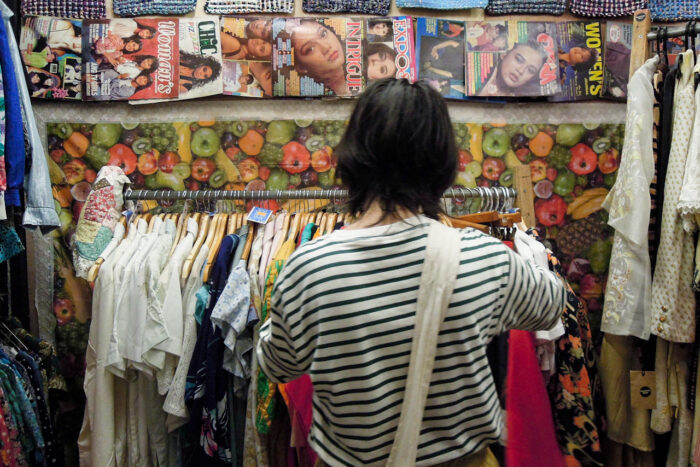Off Paper: The Hidden Cost of Home-based Workers
By: Aastha Jain , member of Fashion Revolution India
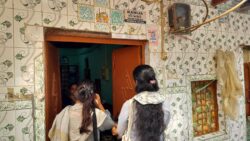 No Policies, No Records—42 million home-based workers remain systematically invisible, with approximately 19% engaged in apparel production. As a policy researcher with the Fashion Transparency Index Working Group between September 2024 and December 2024, I met several women stitching buttons and embroidering and overturning socks in Delhi’s dense colonies, revealing the mechanisms through which capitalist structures perpetuate exploitation, transforming homes into sites of economic negotiation.
No Policies, No Records—42 million home-based workers remain systematically invisible, with approximately 19% engaged in apparel production. As a policy researcher with the Fashion Transparency Index Working Group between September 2024 and December 2024, I met several women stitching buttons and embroidering and overturning socks in Delhi’s dense colonies, revealing the mechanisms through which capitalist structures perpetuate exploitation, transforming homes into sites of economic negotiation.
The informal sector has three archetypes: contractors, piece-rate workers, and self-employed workers. Their labour encompasses completing semi-finished apparel and accessories like bags, shoes, cushion covers, and bangles, assembling bindi packets, attaching buttons, applying trims, packaging, labeling, embroidery, and crochet.
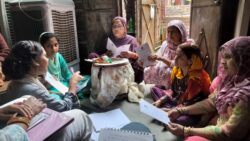 Fixed contractors connected to factories function as intermediaries who distribute work daily or weekly in different neighborhoods. Factories dictate compensation for the contractors. The contractors extract a 40-50% margin before redistributing wages. Piece rates demonstrate huge variability, fluctuating based on geographical location, distance from factories, labour demand, and skills scarcity—ranging from INR 1 ($0.012) to INR 70 ($0.83) per piece. The COVID-19 pandemic exacerbated existing vulnerabilities. Unlike other sectors experiencing recovery post-pandemic, this trade witnessed a wage decline. Contractors, who also tend to be migrant workers, often run away with the due amount. Those who stay nearby or in the same neighborhood as workers show cooperation and timely payment.
Fixed contractors connected to factories function as intermediaries who distribute work daily or weekly in different neighborhoods. Factories dictate compensation for the contractors. The contractors extract a 40-50% margin before redistributing wages. Piece rates demonstrate huge variability, fluctuating based on geographical location, distance from factories, labour demand, and skills scarcity—ranging from INR 1 ($0.012) to INR 70 ($0.83) per piece. The COVID-19 pandemic exacerbated existing vulnerabilities. Unlike other sectors experiencing recovery post-pandemic, this trade witnessed a wage decline. Contractors, who also tend to be migrant workers, often run away with the due amount. Those who stay nearby or in the same neighborhood as workers show cooperation and timely payment.
A shared space for home and work exposes profound gender-based contradictions. Women, responsible for domestic labour, are compelled to negotiate complex frameworks—first fulfilling family responsibilities, then pursuing work in the remaining time. Women decide whether they can accommodate more labour or not as per their domestic schedule. Many women are not allowed to move outside, rendering home-based work as a survival strategy. Work remains fundamentally precarious: no monthly guarantees, with labour oscillating between hectic periods and prolonged intervals of scarcity. The irregularity breeds systemic mistrust and hopelessness, compelling some to abandon this labour mode while others persist as a final economic recourse.
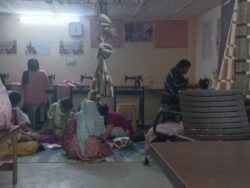 To meet their basic needs, workers try to maximise work, generating low piece-rate wages. Such compensation structures incentivize maximum labour extraction. Families, including children who spend substantial amounts of time with mothers, become integrated into production processes. The fundamental contradiction emerges: how can corporations proclaim freedom from forced or child labour when entire communities are economically coerced into such labour arrangements?
To meet their basic needs, workers try to maximise work, generating low piece-rate wages. Such compensation structures incentivize maximum labour extraction. Families, including children who spend substantial amounts of time with mothers, become integrated into production processes. The fundamental contradiction emerges: how can corporations proclaim freedom from forced or child labour when entire communities are economically coerced into such labour arrangements?
In Delhi, workers inhabit densely populated neighborhoods characterized by open sewage systems, intermittent electricity supply, water scarcity, and inadequate ventilation. Typical living rooms(a 10 x 10 feet space)egregiously contradict International Labour Organization (ILO) conventions mandating workspace requirements. Workers absorb additional economic burdens, including electricity costs, healthcare expenses, and workspace rental, which remain strategically unaccounted for in supply chain calculations.
“Bindi sticking impacts eyesight, back pain, and exposure to chemicals severely. Another such hazard is from clothes made with chemical dyes. During extreme heat in summer, dyes stick to hands causing skin infections. No provision of safety gears, social security schemes, healthcare provisions worsen the worker’s conditions.” – Subadhra Pandey, Representative SEWA in Delhi
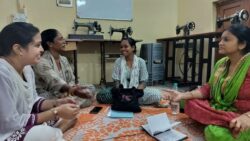 Unionization of informal workers confronts multifaceted obstacles: absence of direct employer contact, lack of governmental protective mechanisms, and the invisibility of home-based labour. Brand identification by workers and the union is impossible within this fragmented production ecosystem. Merely 0.25% of workers comprehend their position within broader supply chains, mentions Subadhra. The proliferation of counterfeit products further obscures potential accountability mechanisms.
Unionization of informal workers confronts multifaceted obstacles: absence of direct employer contact, lack of governmental protective mechanisms, and the invisibility of home-based labour. Brand identification by workers and the union is impossible within this fragmented production ecosystem. Merely 0.25% of workers comprehend their position within broader supply chains, mentions Subadhra. The proliferation of counterfeit products further obscures potential accountability mechanisms.
SEWA is a union of 2.9 million informal workers. SEWA in Delhi serves 70,000 workers out of which 7,000 work in the garment industry as home-based workers. Along with other South Asian organisations, the union has developed a transparency tool called Wage Card to document monthly work and negotiate for fair wages. This tool records transactional details, work performed, payments due, and brand associations.
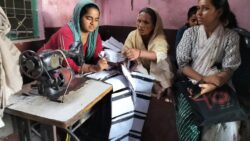 The fundamental struggle demands systemic recognition. Unions articulate comprehensive demands: joint employer responsibility, profit redistribution, social security provisions, regular work, minimum wage guarantees, and most importantly ratification of international labour conventions- C177.
The fundamental struggle demands systemic recognition. Unions articulate comprehensive demands: joint employer responsibility, profit redistribution, social security provisions, regular work, minimum wage guarantees, and most importantly ratification of international labour conventions- C177.
The invisibility of home-based workers reinforces profound epistemic violence—where labour is essential yet systematically marginalized. Most workers do not even acknowledge themselves as workers but as homemakers, wives, or mothers. Their work remains unacknowledged by governments, employers, and manufacturers alike. The hidden costs—including electricity, tools, healthcare, family labor, and unpaid wages—create a perception of cheap production, enabling brands to increase profits by transferring economic burdens to the working class of producing nations.
–
The article is written by Aastha Jain, a visual designer and researcher. She is also a member of Fashion Revolution India. The insights are based on discussions with Subadhra Pandey, Representative SEWA in Delhi, and home-based workers from Delhi. For contact, reach at: aasthajn29@gmail.com
On Paper: Worsening Conditions of Labour in India’s Garment Sector
By: Aastha Jain , member of Fashion Revolution India
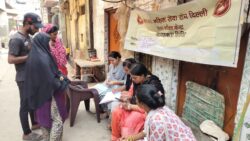
The conditions of workers in producing nations like India reveal a stark contradiction: despite increasing international legislative protections, workers’ lived experiences continue to deteriorate. The acts of intensifying production and alienation of labour have left the workers isolated with stagnant minimum wages and growing monopolization of brands and suppliers. During my time as a policy researcher with the Fashion Transparency Index Working Group between September 2024 and December 2024, I discussed with the union leaders and researchers, the conditions of the garment workers on the shop floor, and the conditions of piece-rate home-based workers in India.
Rukmini VP, President of Garment Labour Union(GLU) highlights that amongst 72 sectors across industries in India, only 4 sectors namely Garment, Leather, Spinning, and Textile have the lowest wages; INR 8,000 ($95) – INR 12,000 ($143) per month (p/m). As per the national law, minimum wages have to be revised every 3-5 years, yet it has stagnated for over a decade in many states. Even if it gets revised its implementation is rare, often retaliated by the factory owners with court cases.
Labour requiring an average of 9 to 11 hours per day (which contradicts Indian Labour Law that limits to 48 hours a week), and paying less than $100 p/m, can increase up to 14 to 16 hours per day during peak seasons.“Workers are allowed a maximum of 30-minute break, and even this is contingent on meeting punishing production targets of 150-200 garment pieces per hour,” says Rukmini VP. Rampant harassment, caste-based discrimination, poor healthcare, and childcare facilities, are further deteriorating the physical, social, and mental conditions of a worker.
“Workers are allowed a maximum of 30-minute break, and even this is contingent on meeting punishing production targets of 150-200 garment pieces per hour,” says Rukmini VP.
The gendered nature of the workforce amplifies these economic challenges. A predominantly female workforce (around 90%) migrates across states to manufacturing districts, being first-generation industrial workers. These migrant workers face heightened risks of harassment, possess weak negotiation power, and experience job insecurity. Underage girls between 14 and 15 years enter factories using falsified age certificates.

In addition to this exploitation which leaves individual workers vulnerable, organising resistance is also made difficult. According to interviewed union representatives, In India, less than 4% of the working class in the garment industry are part of unions. Additionally, they state that the brands, and factories employ extreme forms of tactics to suppress workers from organizing, including targeting the workers, surveillance, economic intimidation, creating yellow trade unions, stopping purchase orders (stop sourcing from that vendor), terminating employment, and threatening organizers, amongst others.
Paradoxically, increasing compliance has created new forms of exploitation. The documentation process has become so complex that specialized firms now solely manage supplier paperwork. Small manufacturers unable to navigate this bureaucratic labyrinth are being systematically eliminated, establishing a monopoly on large manufacturers. The legitimacy of submitted documentation also remains highly non-reflective of the conditions. It remains unreliable due to sole commitment to paper as a tool for auditing. There are no third-party audits or unplanned visits to verify the information shared in the submitted documents. Factory visits are meticulously planned, with workers threatened to maintain silence. The auditors do not engage with the unions who could bear testimony to the true working conditions.

Brands have transferred their responsibility and accountability of ensuring decent working conditions to the suppliers without transferring actual ownership or profits: a sublime act of class manipulation. This paper trail becomes a shield, protecting brands from accountability while maintaining the illusion of ethical production. Workers remain trapped in a system where documentation matters more than real working conditions.
Paper emerges as an instrument of oppression, simultaneously serving as a survival mechanism for the oppressed. Entrenched in their accumulated wealth, the ruling class wields economic instruments, crafting an illusion of autonomy while sharpening the blades of systemic exploitation. Combating global capitalism’s inherent transnational nature, the struggle demands international solidarity. Amidst poor implementation of local state mechanisms, trade unions increasingly rely on global support to negotiate effectively. Their core demands remain fundamental: joint employer responsibility, living wages, union recognition, regular unannounced inspections, and dignified working conditions.
——
The article is written by Aastha Jain, a visual designer and researcher. She is also a member of Fashion Revolution India. The insights are based on discussions with Rukmini VP, Garment Labour Union, Nandita Shivkumar, labour Rights Researcher, and Thivya Rakini, Tamil Nadu Textile Commons Unions. For contact, reach at: aasthajn29@gmail.com
By: So Young Park – Country Coordinator at Fashion Revolution South Korea
We all have old T-shirts with stretched or frayed necklines from countless days of wear and tear. I have clothes tucked away in the back of my wardrobe that I occasionally pull out to reminisce. Volunteering with Fashion Revolution for the past three years has taught me that fashion activism isn’t just about buying clothes with a “sustainable” label. Instead, it’s about digging through your wardrobe, pulling out old clothes, and finding ways to breathe new life into them. I waited until a hole the size of my thumb appeared in a favorite shirt, figured out how to sew it up, covered the hole with thread in my favorite color, and now enjoy the satisfaction of wearing it every time.
My journey into sustainable fashion began in 2020 in a small Batik studio in Jakarta, where I met passionate textile enthusiasts. There, I learned about the craft, history, rituals, and the deep connections between textiles, communities, and respect for nature. This experience profoundly shifted my perspective on life, extending far beyond textiles and fashion. I came to understand that clothing is more than just fabric on our bodies; it represents an ongoing dialogue with the people who make it. It is not something disposable to be taken and thrown away.

In 2021, while traveling through the beautiful landscapes of West Java, I witnessed a polluted river filled with industrial waste and a mountain littered with discarded clothes. It was a shocking sight. My nine-year-old son looked at me and said, “Mum, we have to do something for the planet.” His words stayed with me, and I began searching for ways to make a difference. Together with the dedicated members of Fashion Revolution South Korea, I’ve been volunteering to create digital campaigns that raise awareness about the complex fashion supply chain and its social and environmental impacts. These efforts include an exhibition called ‘Sa-o-ot (Love Clothes Last)’, which highlights the stories of people who have cherished their clothes for years, and translating and distributing the Fashion Transparency Index.
My nine-year-old son looked at me and said, “Mum, we have to do something for the planet.” His words stayed with me, and I began searching for ways to make a difference.

Through translation projects, I’ve met an incredible range of people—fashion designers, students, beauty industry researchers, educational planners, ESG consultants, and others—who have all said that participating in translation and campaign efforts raised their awareness. They expressed that the Fashion Transparency Index helped them understand industry changes and identify areas in need of improvement.
Year after year, the data in the report highlights key issues, revealing both progress and persistent challenges. The fashion industry’s impact varies profoundly across countries, often with devastating consequences. As detailed in the report, fashion can mean vastly different things depending on where you are: from glamorous runway shows to disposable trends that exploit vulnerable communities. In some countries, fashion is tied to women’s rights and freedoms. In others, it’s synonymous with sacrificing children’s education, clean water, and safe working conditions in favor of profits. Each country faces its unique challenges and issues to address within the fashion industry. South Korea, as one of the leading countries in the fashion industry, is no exception to these challenges including the struggles faced by small and medium-sized enterprises (SMEs) due to the weakening of the domestic production base. 
Despite these challenges, there is a universal set of values and directions we must pursue. We must recognize that these issues are not merely obstacles to overcome but opportunities to serve as turning points toward a sustainable future. On Volunteer Day, we honor the countless individuals who dedicate their time and effort to these principles. May their contributions fuel the growth of a just and green transition, paving the way for a more sustainable and equitable future.
By: Claudia Castanheira – Communications Manager at Fashion Revolution Brasil

After two weeks of complex negotiations and over a day of delays, COP29 concluded with the resignation of the poorest and most vulnerable countries, forced to accept a climate finance deal far below the $1 trillion annually demanded by 2035. The final agreement settled on $300 billion per year for climate financing until 2035, the result of over 30 hours of tense talks and setbacks.
Countries in the Global North, including the European Union delegation, the United States, and Canada, who advocated for less ambitious targets, were widely criticized by international observers and NGOs. The European bloc was even awarded the “Fossil of the Day” on November 20, a symbolic prize given by the Climate Action Network (CAN) to those seen as blocking progress during climate talks.
It’s important to highlight that without adequate financial resources, it will be impossible for countries — particularly those in the Global South — to implement climate actions for adaptation, mitigation, and a just energy transition. This lack of funding also puts the Paris Agreement’s goal of limiting global warming to 1.5°C at risk.
Another notable point was the lack of clear commitments to energy transition — including the phase-out of fossil fuels, a central theme of COP28 in Dubai. This objective, removed from the final document in 2023, was not explicitly reinstated in the agreement signed on Saturday, marking a victory for oil and gas-producing countries.
In a geopolitical context marked by wars and crises, achieving significant progress was expected to be a challenging task. However, the general feeling is that this COP resulted in few, if any, meaningful achievements, increasing distrust in the multilateral process to address the climate crisis.
Fashion at COP29
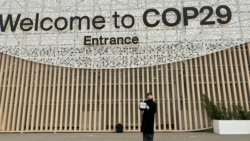
Fashion Revolution Brazil took part in COP29, engaging in discussions with civil society and other stakeholders to highlight the crucial role of fashion and textiles in addressing the climate crisis.
While formal negotiations left much to be desired, we came out stronger: Building new connections and forging global partnerships, which are essential for driving transformation in the industry.
As a civil movement, being part of these spaces is absolutely necessary. Even in the face of roadblocks and insufficient decisions, we reaffirmed our commitment to pursue a more transparent, fairer, and more sustainable fashion industry.
As members of the Brazilian delegation, we put forward clear demands:
For brands:
- Be transparent about how and where clothes are made, how many pieces are produced, and the social and environmental impacts of their production.
- Set ambitious targets for decarbonization and degrowth, and be clear about how these goals will be achieved.
- Publicly share updates on progress and concrete actions to meet these targets.
For policymakers:
- Develop policies to support Brazil and other garment-producing countries facing climate crises and vulnerabilities.
- Prioritize efforts to cut greenhouse gas emissions in the global fashion industry.
- Ensure small suppliers and family farmers have access to financial resources to build resilience against climate change.
At the event, we presented key reports, including What Fuels Fashion, a climate-focused analysis of the Global Fashion Transparency Index, and the latest edition of the Fashion Transparency Index Brazil, which reviews six years of progress and challenges in the industry.
COP30: What is next?
 Looking ahead, our goal is to mobilize the world’s largest civil movement for fashion to come together at COP30 in Belém, Brazil. This will be a landmark event: Brazil is the world’s top exporter of cotton, yet it faces major challenges like carbon emissions from deforestation and a dependency on fossil fuels.
Looking ahead, our goal is to mobilize the world’s largest civil movement for fashion to come together at COP30 in Belém, Brazil. This will be a landmark event: Brazil is the world’s top exporter of cotton, yet it faces major challenges like carbon emissions from deforestation and a dependency on fossil fuels.
The takeaway from COP29 is clear: COP30 must tackle the issues that remain unresolved. We’ll be there in the Amazon rainforest, demanding an end to fossil-fueled fashion and advocating for the rights of those most affected by the climate crisis, often the women who make our clothes.
The fashion climate agenda is just getting started!
Standing together with #FashionforClimate
What can you (citizens) do?
The most anticipated and much-awaited event in VegFest 2023 is the VegFest Runway. A sustainable fashion show that has become a highlight of the festival. This year’s event resonated with creativity and resilience even in the face of a tropical storm. It showcased how fashion can contribute to preserving the environment and saving it from the climate crisis.
The VegFest Runway captivated a blend of innovative designs from three visionary fashion designers and a celebrity stylist. Together, they illustrated the impactful mantra of recycling, reusing, and reducing or the 3Rs. Through these compelling collections, the 3Rs define modern sustainable fashion.
A Showcase of Creativity and Sustainability
The first collection was called “Simply Trashion.” It captivated the audience with its transformative use of everyday recyclable materials. The designer turned empty plastic wrappers into stunning pieces. Shredded rice sacks were also used. They challenged conventional norms about waste by incorporating repurposed fabrics.
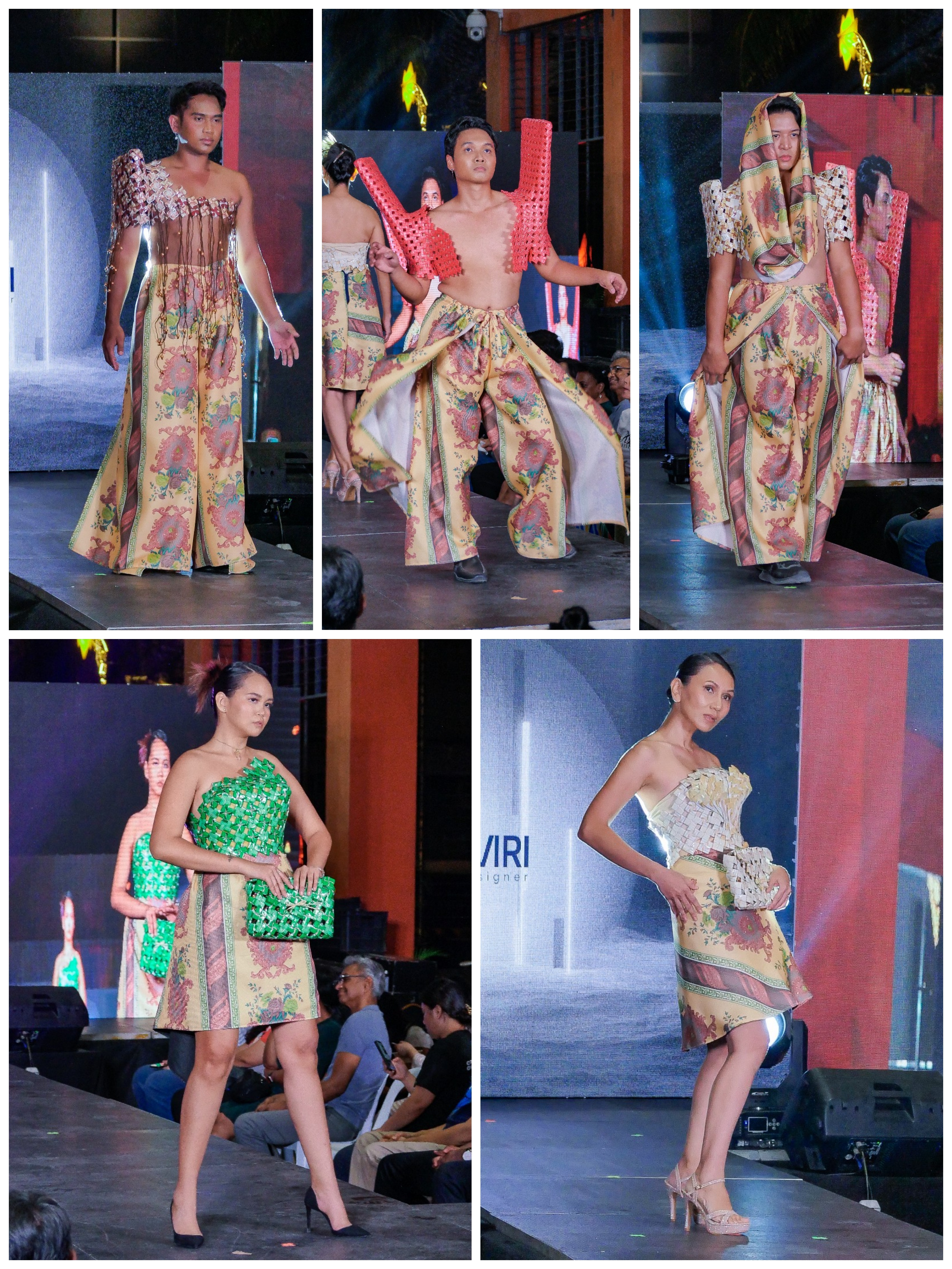
Leby Le Moría followed with a profound presentation. The attendees were treated to a collection that embodied years of introspection. The notion that vulnerability can be a source of strength is an inspiration. Each piece from her collection represented a chapter of her journey. Intricately woven with humanism and creativity.
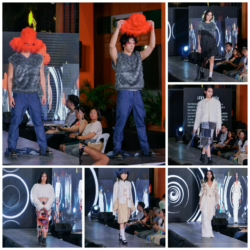
Next in line is Twinkle Ferraren’s Style Isle. The tropical landscapes of the Philippines influenced here we’ll renowned island wear designs. Putting together local artisans and indigenous tribes to encapsulate Filipino artistry. Ferraren’s collection showcased the rich Filipino heritage, and sustainably sourced textiles and accessories.
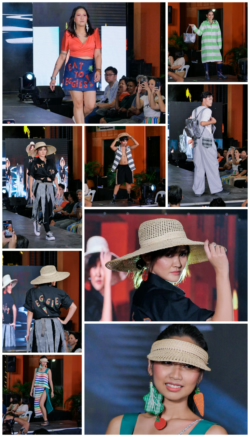
The show’s pulse quickened with celebrity eco-stylist and author Miss Kayce. She highlighted the vegan statement collection in advocating for positive change. Miss Kayce inspired the volunteer models to mix creatively and match pieces from their existing wardrobes. Aligned to their fashion choices with a vegan philosophy. A philosophy while promoting conscious consumerism.
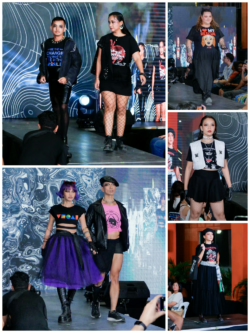
A Spotlight on Emerging Talents
The next day of VegFest 2024 is dedicated to students from SoFA Design Institute. They presented their unique street wear creations on the runway. Their instructor, Irene Grace Subang, guided their creativity to new heights. These budding designers utilized textile scraps donated by Barrios Studios.
Three esteemed experts in sustainable fashion judged the students. The judges are Prince Jimdel Ventura of Wear Forward, Buena Sawit of Barrios Studios, and celebrity stylist author Miss Kayce. They judged the students’ efforts across three categories: Best in Upcycled Construction, Most Innovative, and Best Collection. Additionally, the audience had the chance to vote for their favorite, culminating in an exhilarating People’s Choice award.
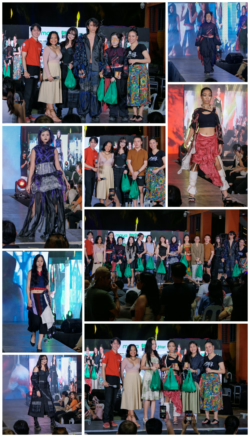
Embracing Eco-Consciousness
The VegFest Runway 2024 persevered to continue despite the looming threat of tropical storm Man-Yi. A powerful reminder of the fashion industry’s potential to drive environmental awareness. It served as a platform for creative expression and also as a conduit for inspiring actionable change.
VegFest Pilipinas, in collaboration with Fashion Revolution Philippines, reiterated its commitment to sustainable fashion. Leaving an indelible mark on the attendees and participants alike. The event successfully merged the worlds of fashion, environmentalism, and cultural heritage. It promoted a collective consciousness toward a more sustainable future.
As the final curtain fell, it was clear. The VegFest Runway has once again proved that style and sustainability can walk hand in hand. Where change is more than envisioned but it’s being woven into the very fabric of our lives.
HEY BIG FASHION BRANDS,
START FINANCING YOUR DECARBONISATION NOW!
COP29, the 29th Conference of the Parties to the United Nations Framework Convention on Climate Change, is poised to be a pivotal event in the global fight against climate change. As usual, the conference will bring together world leaders, negotiators, and stakeholders to assess progress on climate commitments made during previous COP meetings and to discuss strategies for achieving the goals of the Paris Agreement. But we are all fatigued from discussions and commitments, the time is running out and we urgently need action.
As many stakeholders are referring to COP29 as ‘the finance COP’, with negotiations seen as critical to advance a range of financial tools and instruments to support actions to address climate change, we want to reinforce our calling on major fashion brands to invest at least 2% of their revenue in a fair transition away from fossil fuels – like coal – to renewable energy sources – like wind and solar – to power fashion’s supply chain in a clean way.
Fashion is fueling the climate crisis, and major fashion brands must urgently put their money where their emissions are.
Fashion is one of the most polluting industries on the planet, with fossil fuels burned at every stage of production. The industry alone is set to overshoot the 1.5°C limit by 50%, doubling emissions rather than halving them as the science is crying out for. Frequent climate catastrophes, like extreme heat, flooding, and droughts are devastating the livelihoods of workers across global garment supply chains, with extreme weather estimated to cost nearly one million jobs by 2030.
Fashion Revolution’s new report, What Fuels Fashion? reviewed 250 of the world’s largest fashion brands and retailers and ranked them according to their level of disclosure on climate and energy-related data in their operations and supply chains. The findings revealed that major fashion brands aren’t doing enough to cut fossil fuel use in their supply chains. 86% of major fashion brands lack a public coal phase-out target, and only 3% disclose the level of financial support provided to supply chain workers affected by the climate crisis.
By investing at least 2% of their revenue into clean, renewable energy and upskilling and supporting workers, fashion could simultaneously curb the impacts of the climate crisis and reduce poverty and inequality within their supply chains. Climate breakdown is avoidable because we have the solution – and big fashion can certainly afford it.
Our Demands for Fashion Brands:
- Tell us about your clothes: How and where they were made, how many were produced.
-
- Disclose your annual production volumes
- Disclose the fiber mix of your clothes and why are these fibers
- Disclose the prices you pay to suppliers for each item and the wages that workers receive for the production of your garments
- Tell us about your impact: Measure your environmental and social impact and disclose it.
- Disclose your supplier lists (Tier 1 and Tier 2) in an open source easy to usee for others (such as excel, csv or json)
- Disclose your fuel mix across your supply chains by country
- Publish a detailed breakdown of renewable energy procurement type in your operations and supply chain
- Tell us how you are leveraging your power to influence and advocate for a decarbonisation process and just transition in your supplying countries
- Tell us about your targets: Set targets, disclose how you established them, how you plan to meet them, and report on progress.
- Disclose your climate targets, including your supply chain, backed up by a decarbonisation strategy. Oh and don’t forget to share how were suppliers consulted in the establishment of those targets.
- Publish evidence of climate action in the supply chain and how these efforts are reducing greenhouse gas emissions while increasing renewable energy capacity.
- Share how you are supporting your suppliers for a just transition
Our Demands for Policymakers:
- Implement Binding Regulations: Require transparency and corporate accountability on environmental and human rights issues in the global fashion industry.
- Responsible Purchasing Practices: Ensure brand payments to suppliers reflect the true costs of sustainable production.
- Finance the Green Transition: Develop policies that support garment-producing countries facing debt crises and climate vulnerabilities, prioritizing actions to reduce greenhouse gas emissions.
- Direct Financial Support for Suppliers: Facilitate access to financial resources for suppliers to enhance resilience to climate change, with flexible repayment terms and simplified loan processes.
- Equitable Decision-Making Models: Create decision-making frameworks informed by affected stakeholders, ensuring local contexts and regional needs are integrated into climate action planning and implementation.
What can you (citizens) do?
- You can read the What Fuels Fashion report here and share!
- Email your brands here
- Donate here to keep our revolution going
Habi Philippine Textile Council (Habi) took a significant step to partner with Fashion Revolution Philippines (Fash Rev PH). They aim to promote sustainable and ethical fashion. They partnered for a series of engaging workshops during the Habi Market Fair. The event took place from October 18th to 20th, 2024, at the Glorietta Activity Center in Makati City. It highlighted the incredible talent of Filipino weavers. The beauty of natural textiles was also showcased. Additionally, the importance of supporting local brands was emphasized.
This partnership marked a first for Fash Rev PH. It merged their passion for ethical fashion with Habi’s dedication to preserving and promoting the heritage of Philippine textiles. The workshops were vibrant with creativity. They offered a unique opportunity for attendees to immerse themselves in the world of weaving. Additionally, they promoted sustainable practices.
The event kicked off with a captivating introduction to the art of weaving, led by Twinkle Ferraren. Participants experienced the joy of creating something with their own hands. This fostered a sense of accomplishment. It also sparked a creative fire within each attendee.
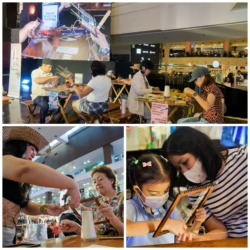
On the second day, Ili Likahaan led a mesmerizing Botanical Eco-printing workshop. Participants discovered the magic of transforming natural textiles using flowers and the rhythmic beat of hammers. This experience was not just about creating beautiful bandannas. It was a journey towards mindful crafting. It also served as a stress-relieving creative outlet.
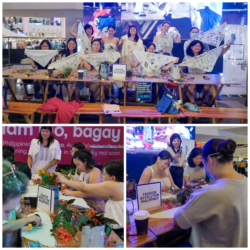
The final day of the workshops showcased the diverse facets of textile artistry. Hiwaga Hands taught participants the art of visible mending. They used techniques like patchwork, embroidery, and sashiko. These techniques breathe new life into fabrics. Meanwhile, The Art of Yarn introduced children to the world of weaving. They used a small loom. This offered a valuable lesson in the craftsmanship and dedication of local weavers.
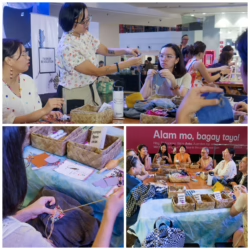
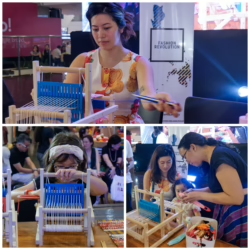
The workshops were a resounding success. Participants gained newfound skills. They also developed a deeper appreciation for the textiles they wear. Additionally, they established a connection to the rich heritage of Filipino weaving. This success demonstrates the power of collaboration. It highlights the growing movement towards conscious consumerism and ethical fashion in the Philippines. The success of this event is a beacon of hope. It inspires others to embrace sustainable fashion choices. It also encourages support for the talented artisans who bring these beautiful textiles to life.
IT’S TIME FOR FASHION BRANDS TO PUT THEIR MONEY WHERE THEIR EMISSIONS ARE
Fashion Revolution, the world’s largest fashion activism movement, is at Climate Week NYC 2024 with a clear message: fashion is fueling the climate crisis, and major fashion brands must urgently put their money where their emissions are.
We’re calling on major fashion brands to invest at least 2% of their revenue in a fair transition away from fossil fuels – like coal – to renewable energy sources – like wind and solar – to power fashion’s supply chain in a clean way.
Fashion is one of the most polluting industries on the planet, with fossil fuels burned at every stage of production. The industry alone is set to overshoot the 1.5°C limit by 50%, doubling emissions rather than halving them as the science is crying out for. Frequent climate catastrophes, like extreme heat, flooding, and droughts are devastating the livelihoods of workers across global garment supply chains, with extreme weather estimated to cost nearly one million jobs by 2030.
Fashion Revolution’s new report, What Fuels Fashion? reviewed 250 of the world’s largest fashion brands and retailers and ranked them according to their level of disclosure on climate and energy-related data in their operations and supply chains. The findings revealed that major fashion brands aren’t doing enough to cut fossil fuel use in their supply chains. 86% of major fashion brands lack A PUBLIC coal phase-out target, and only 3% disclose the level of financial support provided to supply chain workers affected by the climate crisis.
By investing at least 2% of their revenue into clean, renewable energy and upskilling and supporting workers, fashion could simultaneously curb the impacts of the climate crisis and reduce poverty and inequality within their supply chains. Climate breakdown is avoidable because we have the solution – and big fashion can certainly afford it.
WE ARE CALLING ON
- Policymakers to enhance regulation
- Investors to fund and co-fund renewable energy and decarbonisation projects
- Citizens to use their voice- email major brands and retailers and call on them to invest at least 2% of their annual revenues into their decarbonisation and Just Transition efforts
- Civil society, academia, journalists to leverage data and findings to scrutinise and verify the public claims made by brands
Big fashion can no longer mask its lack of decarbonisation progress with vague, insufficient targets and pilot projects that fail to benefit most of the supply chain. The need for system change is undeniable. It’s time for brands to put their money where their emissions are.
You can read the report here. Email your brands here.The Philippines’ longest-running vegan festival, Vegfest Pilipinas, recently celebrated its eighth year with a special event: the ReWork Runway. This eco-vegan fashion show showcased five collections of sustainable and ethical fashion, demonstrating the creativity and innovation that can be found in the world of plant-based clothing.
Why Vegan Fashion?
The fashion industry is a major contributor to environmental pollution, using vast amounts of water and chemicals to produce fabrics and dyes. It is responsible for the exploitation of animals, with leather and other animal by-products being used in clothing. Vegan fashion offers a more sustainable and ethical alternative, using plant-based materials and avoiding the use of animal products. It is a growing trend, with more and more people becoming aware of the environmental and ethical impact of their clothing choices.
The ReWork Runway
The ReWork Runway featured five collections from a variety of designers and brands:
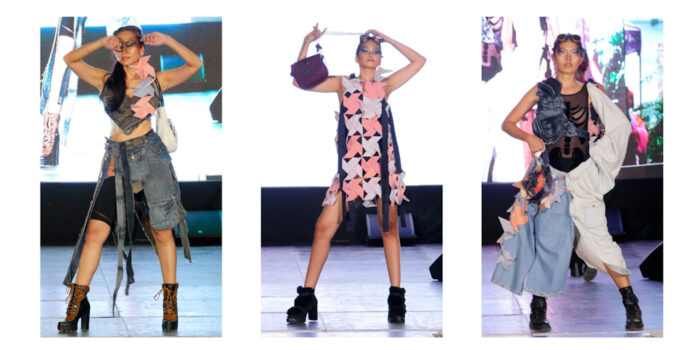
● Irene Grace Subang: A fashion designer and teacher who advocates upcycling. Subang’s collection showed how old denim and textile scraps can be combined to create new and exciting pieces. One of her eye-catching piece has a book leaf design on the right shoulder matched with the pinwheels patterns.

● Re.Clothing: A brand that embroiders and redesigns unwanted clothes to give them new life. The embroidery makes the clothes more personal for the wearer.
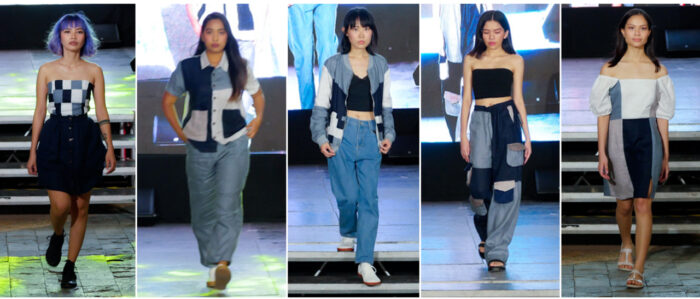
● TelaStory Collective: A brand that manufactures and sells garments that set a good living wage of their female artisans. Their clothing collection shows simplicity inspired from a checker design.
 ● ProjectPH: A brand that uses repurposed white flour sacks to create modern and stylish clothing. This practice dates back in late 1800s but trend went further in the 1929 Great Depression when women repurposed these while flour sacks into clothing.
● ProjectPH: A brand that uses repurposed white flour sacks to create modern and stylish clothing. This practice dates back in late 1800s but trend went further in the 1929 Great Depression when women repurposed these while flour sacks into clothing.
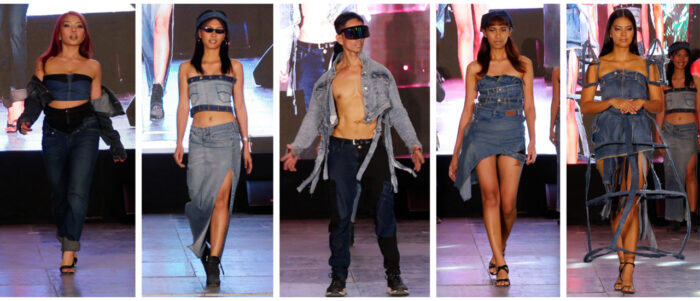
● Euphoria: Ella Alacron‘s collection, a designer whose collection showcased the versatility of denim. Alacron reveals her better woman in redesigning used denim to show more skin.
 A special participation from Leby Le Moria. Her handwoven modular piece from off-cut fabric presented from the start of the runway.
A special participation from Leby Le Moria. Her handwoven modular piece from off-cut fabric presented from the start of the runway.
A Celebration of Creativity and Sustainability The ReWork Runway was a resounding success, demonstrating the potential of vegan fashion to be both stylish and sustainable. The collections showcased a variety of innovative designs and techniques, proving that there is no need to sacrifice style for sustainability. The event helped to raise awareness of the importance of ethical fashion choices. By highlighting the environmental and ethical impact of the fashion industry, the ReWork Runway encouraged attendees to make more conscious choices about the clothes they wear.
The Final thought
The ReWork Runway was a powerful event that celebrated the creativity and sustainability of vegan fashion. It showed that there is a growing movement of designers and brands who are committed to creating stylish and ethical clothing. As more and more people become aware of the importance of sustainable fashion, we can expect to see even more innovative and exciting designs in the years to come.
Manila, Philippines – Wine gets better with age and so does clothes where they gets fabulous with decades. That’s what vintage fashion is all about, give second chances to old clothes. The last Sunday of the May held a vintage community flea market where you can grab as many old clothes as you can.
The vintage community flea market ran a one day event on 28th of May 2023 called “Second Chances” at the Escolta street, Manila. The First United Building hosted the Second Chances event at the first floor. Appropriately, the vintage Art Deco building’s first floor housed the popular Berg’s department store before the malls where built. Now, a second chance to relive the popular department where you can wear all the old goodies that you can.
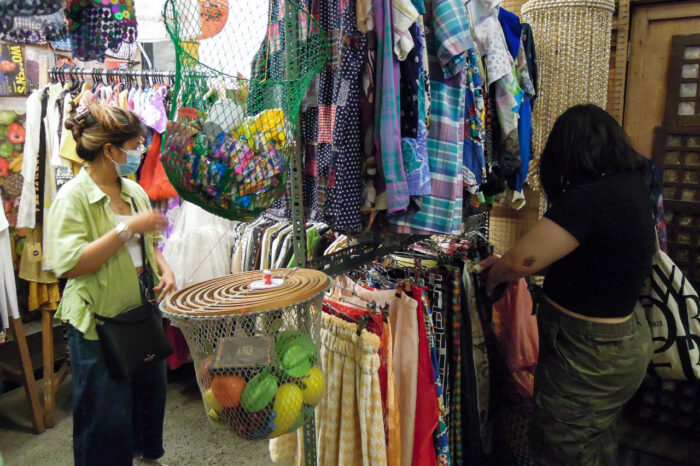
Bring back the good old times
A buffet of the rare, beautiful and luxurious old fashioned clothes from various pop-up stores to vintage vendors. Here you can find Glorious Dias and The Vintage Junkie Manila with pop-up stores Luntian Palamuti Atbp, Wear Kahel, RioTaso, Season Pass and so much more where they help the fashionistas find the those old gorgeous clothes to re-wear them. This vintage community brings back the fashion era from the 1960.
The moment you stepped in you are greeted with an atmosphere from the past. A past that screams with a visual feast of all the vintage clothes with the background music of Manila in the 1960s to 1970s. A fashionista gets drowned with so much choices from clothes to accessories. A feeling of endless creativity and that fashion could never die.
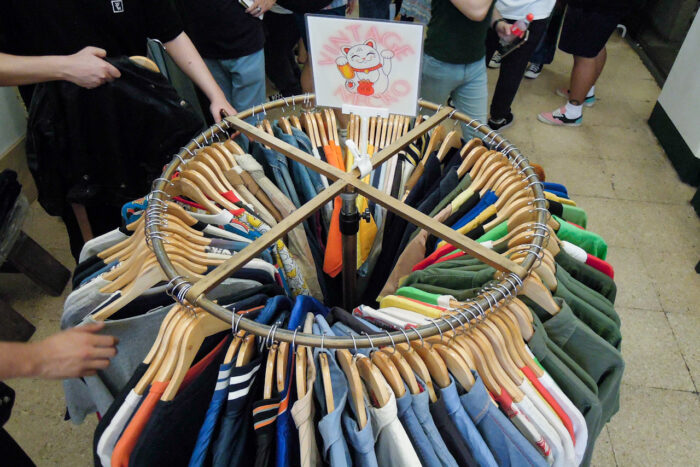
A Fashionista’s dream come true
Jodinand Villaflores Aguillon advocate of upcycled fashion and the owner of Glorious Dias have dreamt of this event for a long time and it finally happened with The Vintage Junkie Manila, Season Pass, Hub Make Lab, Pineapple Lab and The First United Building. A moment where everyone can be on a one stop shop of all vintage as a new fashion or a restyled new trend. People in this event may be unaware that they are already creating an impact. A gesture to buy these old clothes as to repurpose or upcycled already help reduce textile waste that has become one of the major impact to the environment. At the same time, the consumers learned to appreciate these clothes, the people who made them and ourselves. The Second Chances brought such awareness and impact in this small community.
Create a habit of awareness
This one day event created an echo of meaningful gesture. A gesture would hopefully allow modern consumers to understand the value of clothes and the people behind it. An aim to help create a shopper’s habit to spend less and buy smartly on their next fashion items.
The Embassy of Italy in the Philippines together with Home Studio Inc. and with the collaboration of the Philippine Italian Association celebrate the Italian Design Day on 9 March 2023. The first Italian Design Day in the Philippines celebrated with the theme: “THE QUALITY THAT LIGHTS UP. THE ENERGY OF DESIGN FOR PEOPLE and ENVIRONMENT.”
Three masterclasses held before the awarding ceremonies. Masterclasses that presents interior design or product design, fashion, and architecture. The ma for fashion focused at a regenerative approach on sustainable fashion. Christine Cheryl Benet, a Chairperson of Benilde Fashion Design and Merchandising Program, conducts the fashion masterclass titled fashion: “Global Futures: moving towards sustainable fashion” that discussion beyond sustainable fashion.
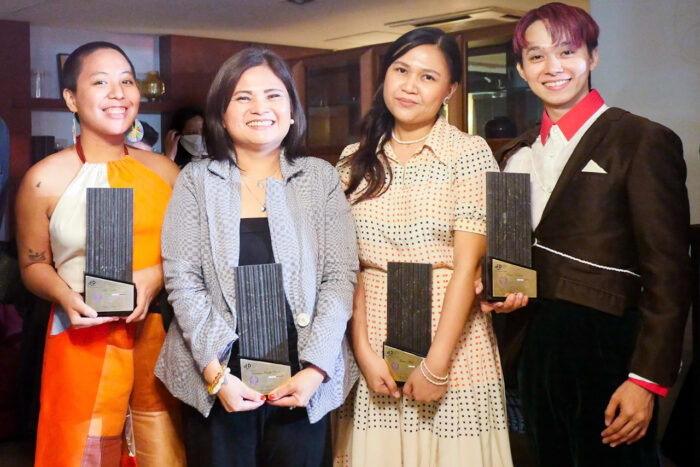
The main event honors 23 personalities both Filipino and Italian nationalities. The Italian Embassy honors personalities from the fashion industry that promotes sustainable and circular economy. The recognition is given to Christine Cheryl Benet, Rags 2 Riches, Rio Cuervo of Rio Taso, Prince Jimdel Ventura of Wear Forward and Spokesperson for Fashion Revolution Philippines, and Theresa Arigo for Fashion Revolution Philippines. The Fashion Revolution Philippines honored as an industry organization in fashion.
Congratulations to all the awardees who continue to promote transparency, sustainability and fair wage in the fashion industry.
La realidad es que la moda está cambiando y es fundamental que estos cambios tengan en cuenta la sostenibilidad y sus efectos duraderos. Globalmente consumimos alrededor de 80 mil millones de prendas nuevas cada año y muchas de ellas van al vertedero después de un período corto de uso. La moda sostenible ya no es una tendencia, sino una necesidad y comprender por qué la necesitamos es el primer paso para una revolución.
La sostenibilidad tiene en cuenta tres pilares indivisibles para garantizar que hoy podamos satisfacer nuestras necesidades sin comprometer a las generaciones futuras. Estos 3 pilares son:
SOCIAL
Para garantizar que los individuos tengan una vida bien mantenida y saludable además de que sus relaciones laborales tengan el objetivo de favorecer el desarrollo personal y colectivo.
MEDIOAMBIENTAL
Para buscar la preservación del medioambiente y reducir el daño causado por nosotros a lo largo del tiempo.
ECONÓMICO
Para aumentar el bienestar social a través de una reducción en la producción y en el consumo, con el apoyo de empresas verdes.
Equilibrar los ámbitos sociales, medioambientales y económicos es la clave para gestionar recursos en un planeta finito, garantizando bienestar social y desarrollo económico.
LA MODA Y LA SOSTENIBILIDAD
Los efectos dañinos de la acción humana ya empiezan a revelarse y la moda sostenible es una alternativa al sistema actual, que propone el uso racional de los recursos naturales, el consumo consciente que rechaza las compras por impulso y la circularidad de la producción. Además, garantiza el bienestar de los trabajadores y promueve el fin de la esclavitud moderna. Crear desde una visión holística y responsable hará que garanticemos una industria más justa para toda la cadena de producción y también para los consumidores.
Desde el punto de vista de la sociedad, estaría bien conocer mejor las marcas que nos gustan y ser curiosos sobre nuestras prendas. Por ejemplo, la campaña #QuienHizoMiRopa surgió de esta inquietud e invita a todos nosotros a preguntarnos y preguntar a las marcas quienes son los involucrados en la producción de nuestras prendas. Una acción sencilla que pone presión en las marcas para que sean más responsables con sus cadenas productivas.
Además, sería necesario disminuir nuestro ritmo de consumo y consumir con más responsabilidad, por ejemplo, preguntándonos si realmente necesitamos aquellas prendas que nos gustaría comprar en las rebajas. Buscar un equilibrio es el primer paso hacia la sostenibilidad.
SÉ CURIOSO, AVERIGUA Y ACTÚA
Desde Fashion Revolution nos proponemos ser un movimiento global de personas e instituciones que luchan por una mejor forma de producir y consumir moda, es decir, por una moda más sostenible. Amamos la moda pero sabemos que el sistema actual nos hace pagar un precio muy elevado por nuestras prendas.
Te invitamos a mirar el trailer subtitulado del documental The True Cost en nuestro canal de YouTube y a hacerte una selfie enseñando la etiqueta de una de tus prendas favoritas, con el cartel ¿Quién hizo mi ropa?
Tras una creciente demanda de recursos en un planeta finito, un aumento en la contaminación y en la explotación de los trabajadores, ha llegado el momento de la moda sostenible. Garantizando el equilibrio de los 3 pilares de la sostenibilidad: social, medioambiental y económico, garantizamos nuestro presente y futuro. ¡Súmate a esta revolución!

